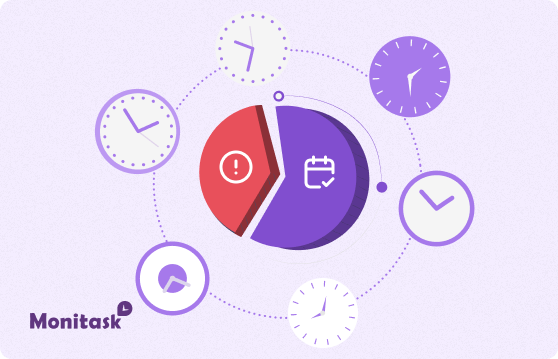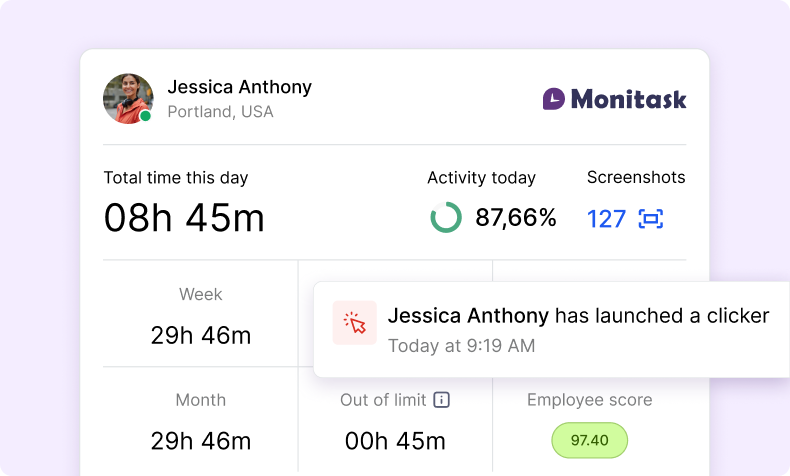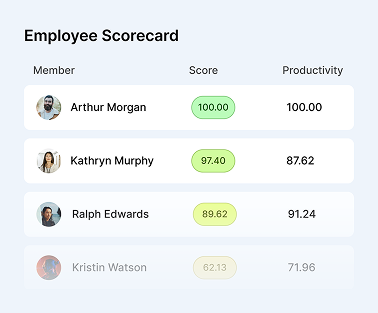What Is Schedule Adherence and Why It Matters for Business Efficiency?

Consistency is one of the most underrated drivers of business success. Even with modern planning tools, many teams still struggle to follow schedules accurately.
Schedule adherence measures how well employees stick to planned work hours, a crucial indicator of discipline, accountability, and overall efficiency.
Whether managing a call center, retail operation, or remote team, improving adherence boosts productivity, customer satisfaction, and profits. Tools like Monitask help organizations track, analyze, and strengthen this vital performance metric.
What Is Schedule Adherence?
Schedule adherence measures how closely employees follow their assigned work hours. It compares scheduled time against the actual time spent working or available for job-related tasks.
For example, if an employee is scheduled from 9 a.m. to 5 p.m. but starts late or takes longer breaks, their adherence rate drops. A worker who follows the plan consistently shows high adherence.
Usually expressed as a percentage, near-100% indicates strong discipline and efficient operations. This metric is crucial in time-sensitive environments like call centers, healthcare, and logistics, but it’s equally useful for remote and hybrid teams to track accountability and workflow balance.
How Schedule Adherence Differs from Schedule Compliance?
While the two terms are often used interchangeably, there’s an important distinction between adherence and compliance.
- Schedule adherence focuses on how closely an employee’s actual working time matches the assigned schedule.
- Schedule compliance, on the other hand, refers to whether an employee follows the correct schedule that was assigned to them.
For example, if an employee swaps shifts without approval but works the full hours, they may be compliant in effort but not adherent to the schedule. Understanding this difference helps managers pinpoint whether issues are related to communication, planning, or time management.
Why Schedule Adherence Matters for Business Efficiency?
Schedule adherence is far more than a measure of punctuality, it’s a direct indicator of how efficiently an organization operates. When adherence is low, disruptions ripple through the entire system: productivity drops, workloads become uneven, and customer experiences suffer.
Here’s how it affects different aspects of business performance:
1. Operational Flow and Resource Management
High adherence ensures that every role is filled at the right time. In call centers or retail environments, even a few minutes of missed coverage can lead to long queues, frustrated customers, and missed opportunities. When staff stick to their assigned hours, managers can balance workloads, prevent overstaffing, and reduce the need for costly overtime.
2. Employee Accountability and Discipline
Schedule adherence also reinforces reliability. Employees who consistently follow schedules demonstrate respect for the team and the organization’s workflow. This doesn’t just improve operations, it strengthens company culture by promoting responsibility and teamwork.
3. Customer Experience
In industries like healthcare, hospitality, and customer service, adherence directly impacts service quality. A delay in answering calls, attending patients, or serving guests can harm reputation and satisfaction scores.
4. Financial Efficiency
Poor adherence leads to inefficiency, which translates into financial loss. Unplanned absences or extended breaks force others to fill gaps, reduce service coverage, and can lead to higher payroll expenses or lost revenue. Maintaining high adherence means operations stay lean and profitable.

5. Data-Driven Decision Making
By tracking adherence data, managers gain insights into productivity trends. Is one team consistently late? Are breaks running longer than scheduled? These patterns help leaders address issues proactively, through coaching, scheduling adjustments, or workflow automation.
In short, adherence is a small number with a big impact.
Schedule Adherence Across Different Industries
The importance of schedule adherence varies slightly by sector but remains universally relevant. Let’s take a closer look at how it applies in different environments.
Call Centers and Customer Support
In a call center, schedule adherence is one of the most closely monitored metrics. Each minute an agent is unavailable affects service levels, response times, and customer satisfaction. Supervisors often calculate adherence to ensure enough agents are online to handle incoming volume efficiently.
Low adherence in this context doesn’t just disrupt workflow, it directly affects profitability. If too many agents take breaks simultaneously or fail to log in on time, queues build up and average handle time increases.
For these environments, real-time adherence tracking is essential. Many centers use workforce management software to monitor logins, breaks, and idle times.
Healthcare
In hospitals or clinics, adherence ensures that patient care remains consistent. When medical professionals or support staff fail to follow schedules precisely, shifts become understaffed, and care quality can decline.
Efficient schedule adherence helps administrators manage rotations, reduce burnout, and maintain compliance with labor laws and patient care standards.
Retail and Hospitality
For customer-facing industries, adherence affects service consistency. A missing cashier or an absent server during peak hours can mean long lines and poor reviews.
In hospitality, for example, maintaining adherence helps balance guest flow, cleaning schedules, and event coordination. A disciplined approach ensures smooth service delivery without overstressing staff.
Remote and Hybrid Teams
The rise of remote work has reshaped how companies think about adherence. When employees work from home or in flexible arrangements, adherence doesn’t necessarily mean being at a desk from 9 to 5, it means being available and productive during agreed-upon hours.
Here’s where tools like Monitask play a transformative role.
Monitask provides automatic time tracking, activity monitoring, and productivity insights without invasive supervision. It allows managers to see when employees are working, what projects they’re focusing on, and how effectively time is being used, all while respecting autonomy.

This approach to digital adherence bridges the gap between flexibility and accountability. Remote teams maintain freedom while ensuring business continuity and efficiency.
How Schedule Adherence Is Calculated?
The calculation is straightforward but powerful:
Schedule Adherence (%) = (Actual Time Worked ÷ Scheduled Time) × 100

For example, if an employee was scheduled for eight hours but only worked seven (excluding approved breaks), their adherence rate would be 87.5%.
Organizations often define acceptable thresholds, for instance, 90–95% adherence is considered strong in most industries. Anything below that may signal workflow inefficiencies or engagement issues.
However, it’s essential to approach these numbers in context. Occasional deviations are normal due to unexpected delays, technical issues, or emergencies. What matters most is identifying consistent patterns that affect performance over time.
Common Causes of Low Schedule Adherence
While every company is different, several recurring factors contribute to low adherence:
Addressing these underlying issues is far more effective than simply enforcing rules.
Improving Schedule Adherence: Practical Strategies
Enhancing adherence requires a mix of structure, empathy, and technology. Organizations that approach it as a shared responsibility, rather than punishment, achieve lasting improvement.
Here are two broad strategies that have proven effective across industries:
1. Build a Culture of Accountability and Respect for Time
Strong adherence starts with culture. When leaders model punctuality, respect schedules, and start meetings on time, teams follow their lead.
Transparency also helps, employees should see how adherence affects productivity and customer experience. Recognizing those who stay consistent reinforces positive behavior.
At the same time, balance accountability with flexibility. Allowing schedule swaps or remote options builds trust and encourages self-discipline without micromanagement.
2. Leverage Smart Technology to Track and Support Adherence
Manual monitoring no longer works in modern workplaces. Digital tools provide an objective, data-driven way to measure and improve adherence.
Monitask is a strong example of how technology simplifies this process. It offers features such as:
✅ Automatic Time Tracking: Employees don’t need to clock in manually; Monitask records activity automatically.
✅ Productivity Reports: Managers can review performance without micromanaging.
✅ Project-Based Monitoring: Adherence can be tied directly to tasks and deliverables, not just presence.
✅ Remote Visibility: Teams working from different locations remain aligned through transparent tracking.

Instead of policing employees, Monitask empowers both sides. Workers can showcase their productivity, while managers gain visibility to make informed scheduling decisions.
This technology-first approach turns adherence from a compliance metric into a collaborative performance tool.
The Human Side of Schedule Adherence
It’s easy to treat adherence as a number, but behind every statistic is a human being managing personal responsibilities, energy levels, and motivation. Overly strict enforcement can backfire, leading to stress and disengagement.
The best-performing companies balance structure with empathy. They use adherence data not as a punishment tool, but as a conversation starter, a way to understand patterns and identify opportunities for support or training.
When combined with flexibility and recognition, adherence monitoring becomes a driver of trust rather than tension. Employees feel seen and supported, not surveilled.
This mindset shift is especially crucial in the era of remote work. Companies that trust their teams, provide the right tools, and communicate expectations clearly see higher adherence naturally.
Boost your business’s productivity
Track performance and streamline teamwork
The Future of Schedule Adherence
AI-driven analytics, predictive scheduling, and automated reporting are transforming how organizations understand time management, shifting from reactive monitoring to proactive optimization.
In the near future, companies will use real-time data to forecast adherence issues before they happen, adapting schedules dynamically based on workload, employee behavior, and productivity patterns.
The future isn’t about stricter oversight, it’s about creating intelligent systems that balance efficiency with empathy, helping teams work smarter, stay engaged, and perform at their best.
Conclusion: Efficiency Starts with Consistency
Schedule adherence is far more than a managerial KPI, it’s a reflection of how well an organization values time, people, and process. When employees show up as scheduled, take breaks responsibly, and maintain steady engagement, the entire business benefits.
From smoother workflows to happier customers and stronger financial performance, adherence drives measurable results. But achieving it requires balance, combining clear expectations, a supportive culture, and modern tracking solutions like Monitask.
In a world where every second counts, consistency is the ultimate competitive advantage. Schedule adherence ensures that every plan, every shift, and every project moves forward on time, and that’s the foundation of true business efficiency.
– The Monitask Team
FAQ: Schedule Adherence Explained
Why is schedule adherence important?
It ensures smooth operations, fair workload distribution, and consistent customer experiences. Poor adherence leads to inefficiency and reduced productivity.
What industries rely most on schedule adherence?
Call centers, healthcare, retail, and logistics depend heavily on adherence to maintain service quality. However, it’s becoming equally important in remote and hybrid teams.
How can I improve my team’s adherence?
Communicate expectations clearly, promote accountability, and use tools like Monitask for transparent time tracking. Recognize and reward punctuality instead of punishing minor slips.



